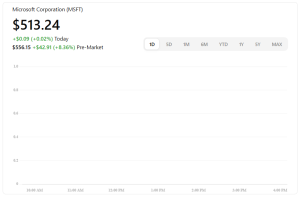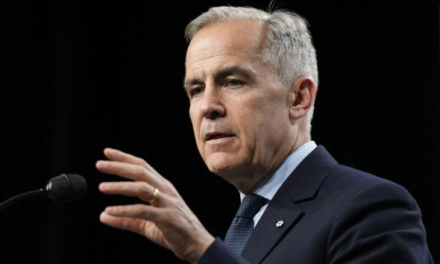Microsoft (NASDAQ: MSFT) is firmly in the spotlight this year—not just for its legacy software businesses, but for its accelerating dominance in cloud computing and artificial intelligence. Its second-quarter fiscal 2025 performance exceeded market expectations, driving deeper investor confidence even as the company commits to massive long-term investments.
Microsoft Corporation (MSFT) is a equity in the USA market. The price is 513.24 USD currently with a change of 0.09000 (0.00018%) from the previous close. The market cap is 2.79 trillion USD. The PE ratio is 28.88. The EPS is 12.93.

Earnings & Financial Strength
In its Q2 fiscal 2025 report, Microsoft posted $69.6 billion in revenue—up about 12% year-on-year—and generated $3.23 per share in earnings, slightly above analyst estimates. Cloud businesses remained at the core of growth:
- Microsoft Cloud revenue rose 21%, reaching $40.9 billion
- AI services hit a $13 billion annualized run rate, advancing 175% year-over-year
Despite the upbeat financials, Microsoft stock briefly dipped about 4–5% in after-hours trading amid investor concern over Azure-related execution challenges and rising capital expenditures. Free cash flow fell nearly 29% year-over-year, reflecting hefty AI infrastructure spending.
Cloud & AI: The Growth Engines
Microsoft’s Intelligent Cloud segment posted revenue of $25.5 billion, growing roughly 19–21%. Azure’s growth stood at 31%, with AI services contributing significantly—around 13 percentage points of that expansion. Growth in search and news advertising also advanced 21%, partly due to enhanced monetization of Bing AI and Edge.
On the productivity side, Microsoft 365 Commercial revenue grew by approximately 15%, Dynamics 365 by 19%, and LinkedIn revenue increased 9%. Meanwhile, the gaming segment saw declines in hardware sales, though content and services partially offset the drop.
Heavy Investing: CapEx and Strategy
Microsoft is doubling down on infrastructure. In fiscal 2025, it plans to spend around $80 billion on AI-enabled datacenters—a leap from past years—and is expected to increase that further in 2026. Recent expectations indicate capital expenditures could exceed $100 billion, signaling the sheer scale of Microsoft’s ambitions.
The company’s AI initiatives are front and center. Integration of OpenAI-powered features into Copilot, Dynamics, Teams, and Azure is driving wide adoption, with forecasts projecting AI-related revenue streams to exceed $50 billion annually by 2027.
Leadership, Strategy & Market Position
Microsoft continues to cultivate its global leadership in AI. In early 2025, CEO Satya Nadella announced a $3 billion commitment to boost AI and cloud infrastructure in India, alongside a goal to train 10 million people by 2030—demonstrating Microsoft’s global scale and community-driven approach.
Industry analysts highlight Microsoft’s strength in hyperscaling infrastructure and enterprise AI. Some recent price targets have been raised to $600, citing superior cloud execution and AI traction—even as Nvidia overtakes Microsoft briefly in valuations.
Analysts & Valuation Outlook
Analysts maintain a mostly bullish stance. All tracked analysts hold a “Buy” rating, with average price targets hovering around $580–600, and a few as high as $613—pointing to earnest confidence in Microsoft’s AI-led growth narrative.
Estimates for Q4 fiscal 2025 suggest revenue could reach $73.9 billion (up approximately 14%) and earnings per share near $3.65, driven by Azure growth of nearly 39% year-over-year.
Risks & Near-Term Headwinds
Despite positive momentum, Microsoft faces challenges:
- Steep capital expenditures are exerting pressure on free cash flow and profit margins
- Operational issues in scaling Azure (especially legacy non-AI services) have dampened growth drivers
- Internal layoffs—including about 9,000 employees in mid-2025—highlight the tension between scaling AI and managing workforce change effectively
- Growing regulatory scrutiny and geopolitical uncertainty could impact global cloud operations and AI partnerships
Looking Ahead: What Matters Most
Microsoft appears to be navigating a pivotal stage: balancing enormous AI and infrastructure investments while maintaining growth in profit and shareholder returns. Key indicators for future performance include:
- Continued strength in Azure and AI services adoption
- The pace and margin impact of capital investment cycles
- Integration success of OpenAI and broader AI tools across enterprise products
- How regulatory and geopolitical pressures shape operations
If Microsoft continues to translate its AI-led ambitions into scalable, profitable growth, upward momentum—and investor confidence—should remain strong.
Final Takeaway
Microsoft’s Q2 fiscal 2025 results reaffirm its position as a cloud and AI powerhouse. With revenue growth of 12–14%, AI services scaling rapidly, and Azure continuing to expand despite execution challenges, Microsoft is clearly executing a long-haul strategy.
Investors seem willing to look past near-term cost pressures—most analysts still view the stock as a compelling long-term play, with targets in the $580–600 range and optimism fueled by AI monetization potential. The real test now will be delivering consistent results while navigating intense AI competition, high capital expenditure demands, and internal transitions.
Microsoft isn’t just evolving—it’s reshaping the enterprise tech landscape. If you’re tracking AI-driven growth, cloud scale, or long-term structural transformation in big tech, MSFT remains one of the most important stories to watch.






